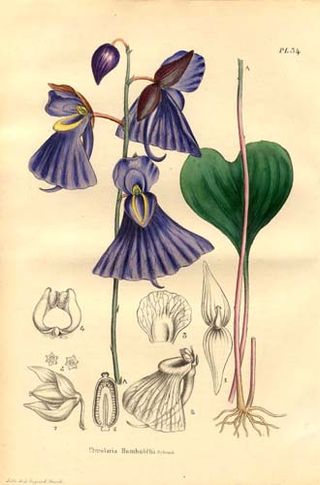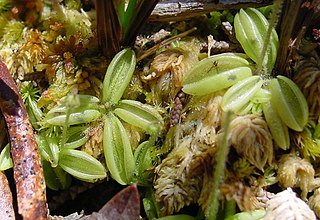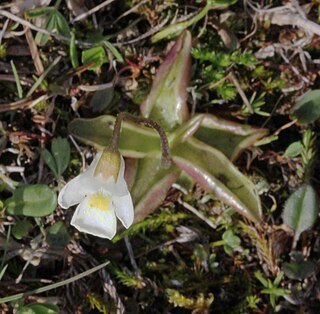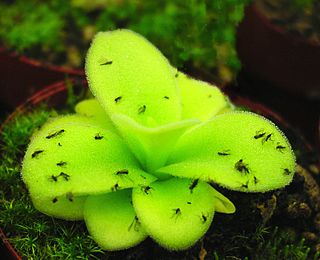
Zinnia is a genus of plants of the tribe Heliantheae within the family Asteraceae. They are native to scrub and dry grassland in an area stretching from the Southwestern United States to South America, with a centre of diversity in Mexico. Members of the genus are notable for their solitary long-stemmed 12 petal flowers that come in a variety of bright colors. The genus name honors German master botanist Johann Gottfried Zinn (1727–59).

Lentibulariaceae is a family of carnivorous plants containing three genera: Genlisea, the corkscrew plants; Pinguicula, the butterworts; and Utricularia, the bladderworts.

Acacia, commonly known as the wattles or acacias, is a large genus of shrubs and trees in the subfamily Mimosoideae of the pea family Fabaceae. Initially, it comprised a group of plant species native to Africa and Australasia. The genus name is New Latin, borrowed from the Greek ἀκακία, a term used by Dioscorides for a preparation extracted from the leaves and fruit pods of Vachellia nilotica, the original type of the genus. In his Pinax (1623), Gaspard Bauhin mentioned the Greek ἀκακία from Dioscorides as the origin of the Latin name.

Pinguicula moranensis is a perennial rosette-forming insectivorous herb native to Mexico and Guatemala. A species of butterwort, it forms summer rosettes of flat, succulent leaves up to 10 centimeters (4 in) long, which are covered in mucilaginous (sticky) glands that attract, trap, and digest arthropod prey. Nutrients derived from the prey are used to supplement the nutrient-poor substrate that the plant grows in. In the winter the plant forms a non-carnivorous rosette of small, fleshy leaves that conserves energy while food and moisture supplies are low. Single pink, purple, or violet flowers appear twice a year on upright stalks up to 25 centimeters long.

Pinguicula lusitanica, commonly known as the pale butterwort, is a small butterwort that grows wild in acidic peat bog areas along coastal atlantic western Europe from western Scotland and Ireland south through western England and western France to the Iberian Peninsula and Morocco in north-western Africa.

Corchorus capsularis, commonly known as white jute, is a shrub species in the family Malvaceae. It is one of the sources of jute fibre, considered to be of finer quality than fibre from Corchorus olitorius, the main source of jute. The leaves are used as a foodstuff and the leaves, unripe fruit and the roots are used in traditional medicine.

Pinguicula grandiflora, commonly known as the large-flowered butterwort, is a temperate insectivorous plant in the Lentibulariaceae family. One distinguishing feature of the species is its flower, which is much larger than the average for the genus.
Siegfried Jost Casper was a German biologist whose primary research was in limnology and the plant genus Pinguicula. Together with Heinz-Dieter Krausch he published a basic reference work on the freshwater flora of central Europe. For many years he studied the East German lake Stechlinsee as well as the river Saale. In 1966 he published a monograph of the genus Pinguicula, a work that is still in use today. He described at least 14 new species, most recently Pinguicula lippoldii and Pinguicula toldensis in 2007. He served as head of the Botanical Garden of the Friedrich Schiller University of Jena and from 1990 until his death was a member of the "Akademie Gemeinnütziger Wissenschaften" in Erfurt.

Pinguicula alpina, also known as the alpine butterwort, is a species of carnivorous plant native to high latitudes and altitudes throughout Eurasia. It is one of the most widespread Pinguicula species, being found in mountainous regions from Iceland to the Himalayas. Native to cold climates, it is a temperate species, forming prostrate rosettes of green to red leaves and white flowers in the summer and a tight hibernaculum during a period of winter dormancy in the winter. Like all members of the genus, P. alpina uses mucilaginous glands covering the surface of its summer leaves to attract, trap, and digest arthropod prey.

Pinguicula primuliflora, commonly known as the southern butterwort or primrose butterwort, is a species of carnivorous plant belonging to the genus Pinguicula. It is native to the southeastern United States. The typical variety forms a white flower in blooming. Like other butterworts, it has sticky adhesive leaves which attract, capture and digest arthropod prey in order to supply the plant with nutrients such as nitrogen not found in the nutrient poor, acidic soil that it grows in. Its name derives from the fact it is usually the first one to flower in the spring.

Pinguicula gigantea is a tropical species of carnivorous plant in the family Lentibulariaceae. Its native range is within Mexico. P. gigantea's flower is usually a purple colour with the occasional light blue also seen. P. gigantea was once classified as Pinguicula ayautla.
This is a list of plants which includes trees and other herbs, vines, climbers, lianas, shrubs, subshrubs that are native or endemic, found in Cuba.

Pinguicula vulgaris, the common butterwort, is a perennial carnivorous plant in the bladderwort family, Lentibulariaceae.

Pinguicula orchidioides is a perennial rosette-forming insectivorous herb native to Mexico and Guatemala. A species of butterwort, it forms summer rosettes of flat, succulent leaves up to 5 centimeters (2 in) long, which are covered in mucilaginous (sticky) glands that attract, trap, and digest arthropod prey. Nutrients derived from the prey are used to supplement the nutrient-poor substrate that the plant grows in. Uniquely among Pinguicula species from the Americas, p. orchidioides produces gemma-like basal buds which elongate into stolons and serve as a means of asexual reproduction. In the winter the plant forms a non-carnivorous rosette of small, fleshy leaves that conserves energy while food and moisture supplies are low. Single purple flowers appear between July and September on upright stalks up to 22 centimeters long.

The International Pinguicula Study Group Newsletter was the official publication of the International Pinguicula Study Group, a Pinguicula society based in the United Kingdom that was active during the 1990s. Typical articles included matters of horticultural interest, field reports, and scientific studies. Only 10 issues were ever released and the newsletter had an irregular publication history. In chronological order, the 10 issues were: volume 1, volume 2, volume 3, volume 4, volume 5, volume 6, volume 7, volume 8, volume 9, and volume 10. The International Carnivorous Plant Society hosts an online archive of all ten issues.

Pinguicula, commonly known as the butterworts, is a genus of carnivorous flowering plants in the family Lentibulariaceae. They use sticky, glandular leaves to lure, trap, and digest insects in order to supplement the poor mineral nutrition they obtain from the environment. Of the roughly 80 currently known species, 13 are native to Europe, 9 to North America, and some to northern Asia. The largest number of species is in South and Central America.

Zinnia elegans known as youth-and-age, common zinnia or elegant zinnia, is an annual flowering plant in the family Asteraceae. It is native to Mexico but grown as an ornamental in many places and naturalised in several places, including scattered locations in South and Central America, the West Indies, the United States, Australia, and Italy.

Zinnia peruviana, the Peruvian zinnia, is an annual flowering plant in the family Asteraceae. It is native to North America and South America.















